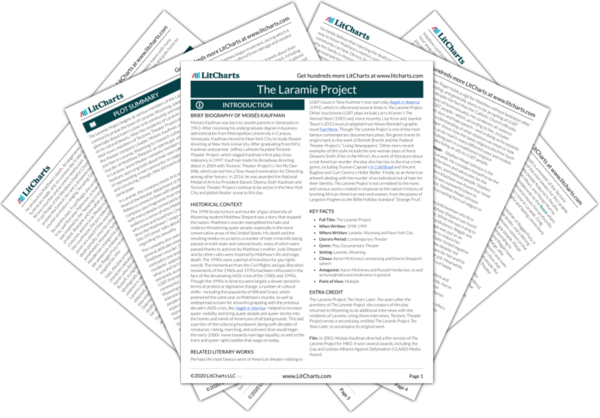After Aaron McKinney and Russell Henderson beat Matthew Shepard, Russell tied Matthew to a fence and the two men left him there to die. The next day, Aaron Kreifels, a local student, found Matthew unconscious, still tied to the fence. The fence where Matthew was found is on the outskirts of town, and the spot offers a view of the city lights, the stars, and the beautiful, stark landscape. After Matthew dies, the fence becomes a pilgrimage site where people go to meditate on their grief, the hatred that led to the crime, and the possibilities for the town’s recovery. Members of Tectonic Theater Company and local people make trips to the fence to pay their tributes to Matthew, and some of them find themselves moved to tears. The fence is referred to throughout the play as both a site of violence and of redemption, where people can go to acknowledge hatred and think about Laramie’s fight against bigotry. The fence thus represents both the incredible violence of Matthew’s murder, and Laramie’s increased awareness in its aftermath.
The Fence Quotes in The Laramie Project
Now, those two people, the accused… I think they deserve the death penalty…Now as for the victim, I know that that lifestyle is legal, but I will tell you one thing. I hope that Matthew Shepard as he was tied to that fence that he had time to reflect on a moment when someone had spoken the word of the Lord to him—and that before he slipped into a coma he had a chance to reflect on his lifestyle.
It just hit me today, the minute that I got out of the courthouse. That the reason that God wanted me to find him is, for he didn’t have to die out there alone, you know. And if I wouldn’t’ve came along, they wouldn’t’ve found him for a couple of weeks at least. So it makes me feel really good that he didn’t have to die out there alone.
And I remembered to myself the night he and I drove around together, he said to me, “Laramie sparkles, doesn’t it?” And where he was up there, if you sit exactly where he was, up there, Laramie sparkles from there…Matt was right there in that spot, and I can just picture in his eyes, I can just picture what he was seeing. The last thing he saw on this earth was the sparkling lights.

















